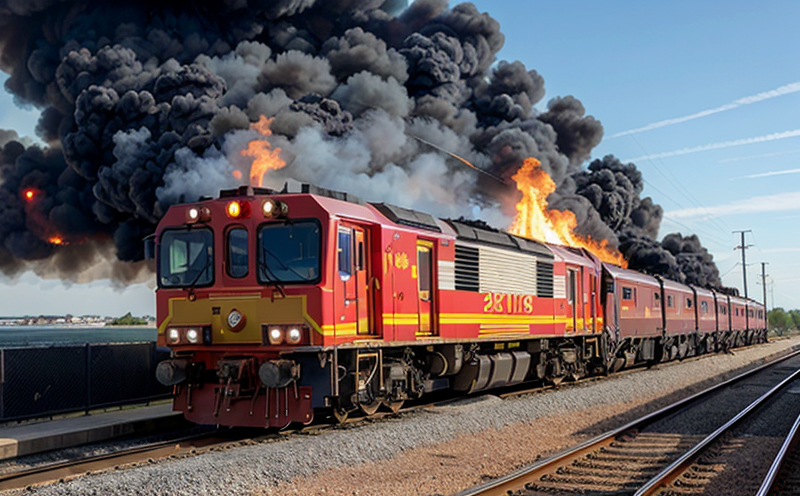Fire Behavior Testing of Railway Plastic Components
The fire behavior testing of railway plastic components is a critical process that ensures the safety and reliability of vehicles in an industry where fire incidents can have severe consequences. This service examines how plastics behave under fire conditions, assessing their ignition propensity, flame spread rate, smoke production, heat release rates, and toxicity levels.
These tests are essential for compliance with international standards such as ISO 1367-2, which outlines the procedures for determining the burning characteristics of upholstered furniture. The results from these tests help manufacturers understand how different materials will react in a fire scenario, enabling them to make informed decisions about material selection and design improvements.
For quality managers and compliance officers, this service provides assurance that products meet stringent safety requirements. For R&D engineers, it offers insights into the performance of new materials and designs under fire conditions. Procurement teams can use these test results to ensure suppliers are meeting the necessary standards. The testing process involves rigorous specimen preparation, exposure to controlled fire environments, and detailed analysis of the outcomes.
The apparatus used in this test includes specialized furnaces capable of simulating various types of fires and environments, such as those found on trains or in railway stations. Specimens undergo pre-treatment steps like cleaning, conditioning, and positioning before being subjected to standardized testing protocols.
- Specimen preparation involves ensuring uniformity across samples for accurate comparison.
- Furnaces provide controlled conditions to ensure consistent test results.
- Sensors measure critical parameters during the fire exposure phase.
- Data analysis software processes and interprets raw data into actionable insights.
The acceptance criteria for this type of testing are stringent, focusing on preventing dangerous situations like flashover or catastrophic failure. Compliance with these standards helps protect passengers, crew members, and infrastructure from potential hazards associated with fires in railway environments.
Understanding the fire behavior characteristics of plastics is crucial for designing safer vehicles that can withstand accidental ignition without compromising passenger safety. By leveraging the insights gained through this testing process, manufacturers can enhance product performance while adhering to regulatory guidelines. This ensures not only compliance but also a higher level of trust among passengers and stakeholders.
In summary, fire behavior testing plays an indispensable role in safeguarding railway systems against fire hazards. It provides valuable data that informs material choices and design modifications aimed at improving overall safety standards within the industry. Through comprehensive analysis conducted under strict protocols, this service contributes significantly to maintaining high levels of public confidence and operational efficiency.
Benefits
The fire behavior testing of railway plastic components offers numerous advantages that contribute directly to enhancing safety measures within the industry. By identifying potential vulnerabilities early on in development cycles, manufacturers can address issues before they become critical problems during production or deployment.
- Improved Safety: Ensures that materials do not ignite easily and spread flames rapidly, reducing risk of fire escalation.
- Enhanced Compliance: Meets regulatory requirements set by organizations like ISO and EN, ensuring legal adherence without compromising quality.
- Informed Design Decisions: Provides engineers with detailed information about material performance under fire conditions, leading to better design choices.
- Increased Confidence: Builds trust among passengers and stakeholders regarding the safety of railway vehicles.
These benefits collectively translate into a safer environment for everyone involved in railway operations. The insights gained from rigorous testing help create more robust solutions that stand up to real-world challenges, ultimately contributing to greater operational reliability and peace of mind.
Why Choose This Test
Selecting fire behavior testing for railway plastic components is a strategic decision based on several factors. First and foremost, it aligns with international standards such as ISO 1367-2, ensuring that the tested materials meet globally recognized benchmarks for safety and performance.
Secondly, this type of testing provides invaluable data that informs design decisions early in the product lifecycle, allowing manufacturers to identify and rectify any shortcomings before costly changes become necessary. Early intervention can prevent delays and cost overruns associated with redesigning products post-production.
Thirdly, by choosing fire behavior testing, organizations demonstrate their commitment to passenger safety and regulatory compliance. This proactive approach enhances public trust and confidence in the railway industry's ability to provide safe transportation services.
Furthermore, adhering to these tests helps establish a reputation for excellence that attracts customers seeking reliable products. In today’s competitive market, maintaining high standards of quality is key to long-term success.
Lastly, investing in fire behavior testing offers protection against potential legal liabilities and financial losses resulting from accidents or incidents involving railway vehicles. Demonstrating due diligence through rigorous testing ensures that any issues are addressed promptly and effectively, minimizing risks associated with non-compliance or substandard products.
Quality and Reliability Assurance
Ensuring the quality and reliability of railway plastic components is paramount to maintaining safe and efficient operations. To achieve this, we employ a multi-faceted approach encompassing rigorous testing methodologies, advanced analytical techniques, and stringent acceptance criteria.
- Rigorous Testing Protocols: Utilize state-of-the-art equipment designed specifically for fire behavior analysis, ensuring precise measurement of key parameters like flame spread rate and heat release rate.
- Data Analysis Software: Leverage sophisticated software tools capable of processing complex datasets into clear, actionable insights. This enables us to provide comprehensive reports tailored to the specific needs of our clients.
- Compliance Verification: Regularly review test results against international standards such as ISO 1367-2 and EN 50284 to ensure full compliance with relevant regulations.
- Continuous Improvement: Based on feedback from tests, we continually refine our methods and procedures to stay ahead of evolving industry trends and demands.
This comprehensive quality assurance framework guarantees that every component undergoes thorough evaluation before being deemed suitable for use in railway applications. By adhering strictly to these rigorous standards, we maintain a high level of reliability across all aspects of the manufacturing process.





